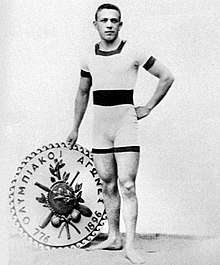Alfréd Hajós
Alfréd Hajós (1 February 1878 – 12 November 1955) was a Hungarian swimmer, football player and manager, and architect.[1] He was the first modern Olympic swimming champion and the first Olympic champion of Hungary. No other swimmer ever won such a high fraction of all Olympic events at a single Games.
 Hajós in Athens 1896 | |||||||||||||||||||||||
| Personal information | |||||||||||||||||||||||
|---|---|---|---|---|---|---|---|---|---|---|---|---|---|---|---|---|---|---|---|---|---|---|---|
| Full name | Alfréd Hajós-Guttmann | ||||||||||||||||||||||
| Nationality | |||||||||||||||||||||||
| Born | 1 February 1878 Budapest, Austro-Hungarian Empire | ||||||||||||||||||||||
| Died | 12 November 1955 (aged 77) Budapest, Hungarian People's Republic | ||||||||||||||||||||||
| Sport | |||||||||||||||||||||||
| Sport | Swimming | ||||||||||||||||||||||
| Strokes | Freestyle | ||||||||||||||||||||||
| Club | Magyar Testgyakorlók Köre | ||||||||||||||||||||||
Medal record
| |||||||||||||||||||||||
Biography
Hajós was born in Budapest, Hungary, as Arnold Guttmann. He was 13 years old when he felt compelled to become a good swimmer after his father drowned in the Danube River. He took the name Hajós (sailor in Hungarian) for his athletic career because it was a Hungarian name.
In 1896, Hajós was an architecture student in Hungary when the Athens Games took place. He was allowed to compete, but permission from the university to miss class was difficult to obtain. When he returned to the Dean of the Polytechnical University, the dean did not congratulate Hajós on his Olympic success, but instead said: "Your medals are of no interest to me, but I am eager to hear your replies in your next examination."
At the 1896 Games, the swimming events were held in the Mediterranean Sea battling the elements. The 18-year-old Hajós won his two gold medals in extremely cold weather (the water temperature was about 55 °F (13 °C), or 13 degrees Celsius) with 12-foot (4 m) waves crashing down on him. He won the 100-metre freestyle with a time of 1:22.2, and the 1,200-metre freestyle in 18:22.1. Hajós wanted to win all three distances, but the 500-metre freestyle was immediately after the 100 and immediately before the 1,200. Before the 1,200-metre race, he smeared his body with a half-inch (one centimetre) thick layer of grease, but it proved to be of little protection against the cold. He confessed after winning the race that, "My will to live completely overcame my desire to win." While at a dinner honoring Olympic winners, the Crown Prince of Greece asked Hajós where he had learned to swim so well. Hajós replied, "In the water." The next morning, the Athenian journal Acropolis depicted Alfréd with the subtitle: "Hungarian Dolphin".[2] He was the youngest winner in Athens.
Prior to the Athens Olympics, Hajós was the 100 metre freestyle European swimming champion in 1895 and 1896.
A versatile athlete, he won Hungary's 100 metre sprint championship in 1898, as well as the National 400 metre hurdles and discus titles. He also played forward on Hungary's national soccer championship teams of 1901, 1902, 1903 – and played in the first international match played by the Hungarian national team, against Austria in Vienna on 12 October 1902.[3] Between 1897 and 1904 he was also a football referee, and during 1906 he was the coach of Hungary's national football team.
In 1924, Hajós, an architect specializing in sport facilities, entered the art competitions at the Paris Olympic Games. His plan for a stadium, devised together with Dezső Lauber (who played tennis in the 1908 Summer Olympics), was awarded the silver medal; the jury did not award a gold medal in the competition. Thus making him one of only two Olympians ever to have won medals in both sport and art Olympic competitions.
The best known sports facility designed by Hajós is the Alfréd Hajós National Swimming Stadium built on Margitsziget (Margaret Island) in the Danube in Budapest, which was built in 1930, and used for the 1958, 2006 and 2010 European Aquatics Championships, and the 2006 FINA Men's Water Polo World Cup.
In 1953, the International Olympic Committee awarded him the Olympic diploma of merit. He is a member of the International Swimming Hall of Fame, and in 1981 he was also made a member of the International Jewish Sports Hall of Fame.
His brother, Henrik Hajós, won gold medal in 4x250 m Freestyle swimming at 1906 Olympic Games in Athens.
Buildings
His first designs were in Art Nouveau and eclectic style, later he turned to modernism and was influenced by Italian styles.
- Hotel Aranybika, Debrecen
- Gymnasium of Janko Francisci - Rimavský, (Levoča, 1913)
- Protestant Church Centre, Budapest
- Újpest FC's UTE Stadium, Újpest, Megyeri ut (1922)
- Swimming Stadium, Budapest, Margitsziget (today it bears his name)
- Millenáris Sportpálya, Budapest XIV
- Sports ground, Miskolc
- Sports ground, Pápa
- Sports ground, Szeged
- Sports ground, Kaposvár
- Girls' School (Hungarian: III. állam polgári leányiskola Pozsonyban, Slovak: III. štátna meštianska škola dievčenská v Bratislave) 1914, Bratislava
- Népkert Vigadó, Miskolc, Népkert
- Swimbath, Szeged (Ligetfürdő, 1930)
Gallery
 Weidlich House in Miskolc (1912)
Weidlich House in Miskolc (1912) Grand Hotel Aranybika in Debrecen (1913)
Grand Hotel Aranybika in Debrecen (1913) Vigadó Restaurant in the Peoples Park of Miskolc
Vigadó Restaurant in the Peoples Park of Miskolc Millenáris Sportpálya in Budapest XIV (1928)
Millenáris Sportpálya in Budapest XIV (1928) Alfréd Hajós National Swimming Stadium in Budapest (1930)
Alfréd Hajós National Swimming Stadium in Budapest (1930)- Napraforgó Street 17 Bauhaus-style building in Budapest
References
- "Alfréd Hajós". Olympedia. Retrieved 22 July 2020.
- "Archived copy". Archived from the original on 21 July 2011. Retrieved 10 March 2010.CS1 maint: archived copy as title (link)
- "Alfréd Hajós". eu-football.info. Retrieved 17 March 2011.